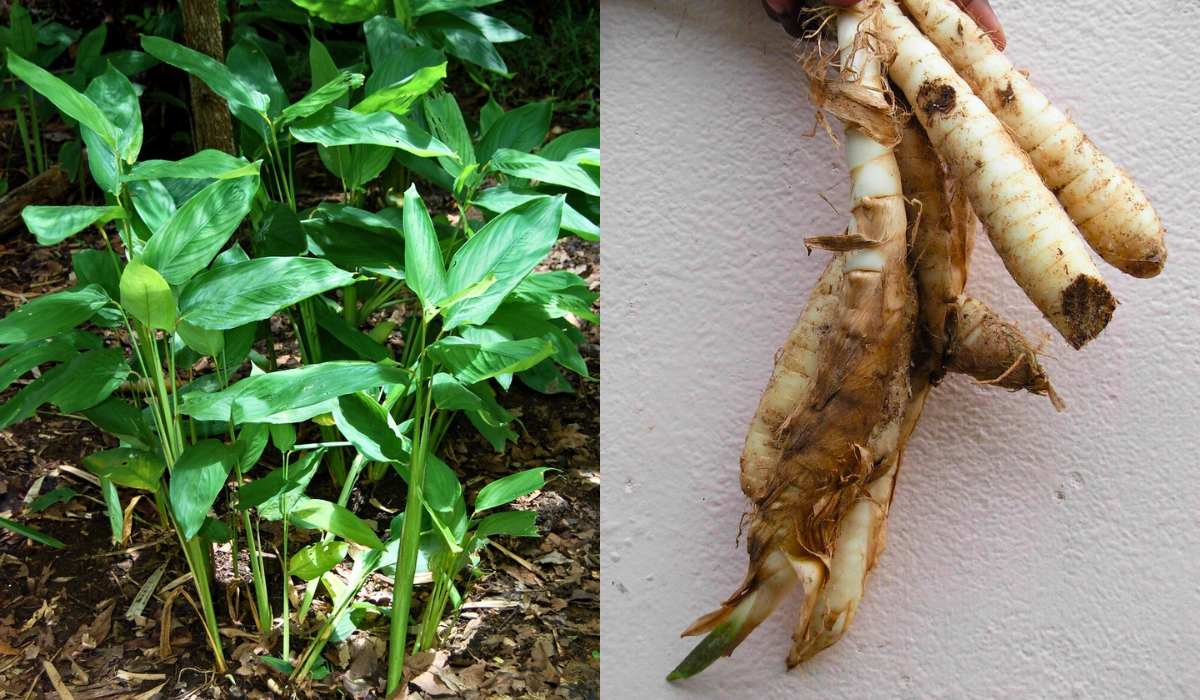Arrowroot Powder Uses I Love & Why I Always Keep Arrowroot Powder on Hand
Arrowroot powder is one of those ingredients I keep returning to: quietly brilliant, endlessly versatile, and always gentle on the skin.
Over the years, I’ve come to love it not just as a formulator but as someone who deeply values practical, uncomplicated beauty and skincare.
It’s soft, it’s breathable, and it works in ways that most people don’t realise until they’ve tried it.
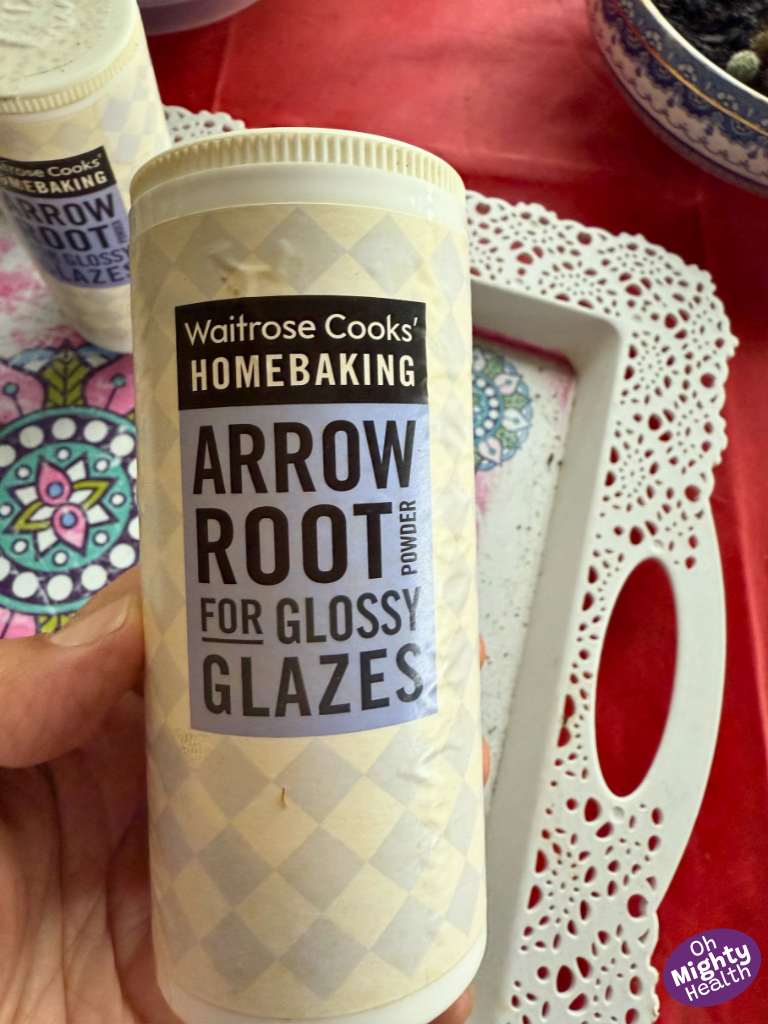
If you’re into natural living and you’ve got a bag of arrowroot in your cupboard, you’re sitting on a goldmine.
This isn’t just something for thickening sauces: it’s a plant-based powder that quietly supports your skin, your home, and your beauty routine in the most thoughtful, grounded way.
Below you’ll find every non-culinary use I truly stand behind. Each one written to be helpful, honest, and easy to follow.
Whether you’re looking to keep your skin fresh, balance your scalp, make your own deodorant, or just keep your shoes from getting that lived-in smell, there’s something here you can put to use today.
Let’s get into it.
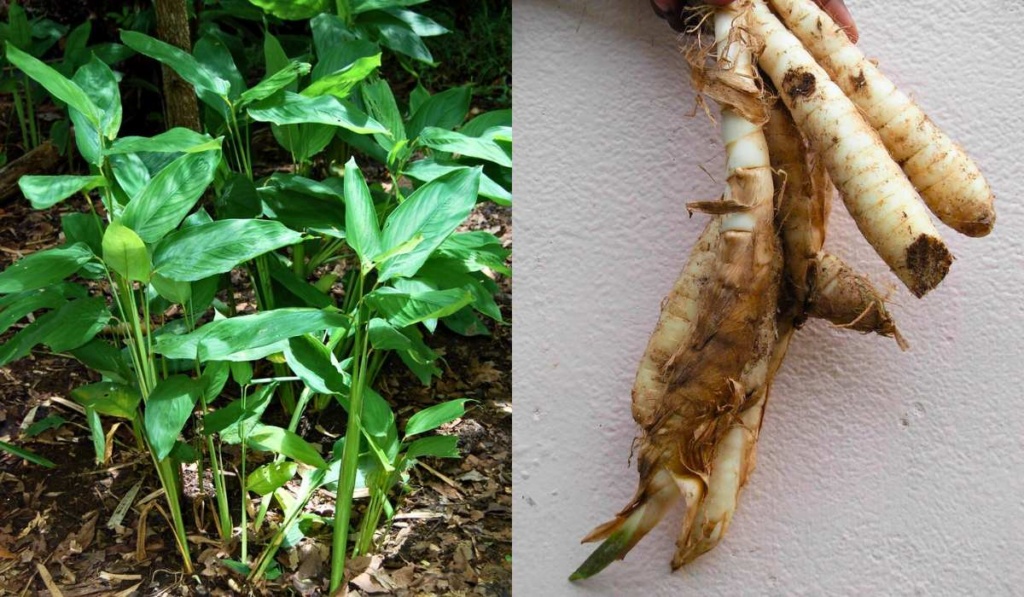
What exactly is arrowroot powder?
It might not look like much, but arrowroot powder is one of those humble ingredients that quietly does a lot. Made from the root of a tropical plant called Maranta arundinacea, it’s a soft, white starch that feels almost silky to the touch. You’ll often find it in natural skincare because it’s so gentle. It blends easily with oils and powders, so it works beautifully in everything from deodorants to dry shampoos. If you’re after something that supports the skin without getting in the way, arrowroot is a lovely one to have around!
Disclaimer: I link to affiliate products below. If you purchase using my link I might earn a commission at no extra cost to you.
1. Natural body powder
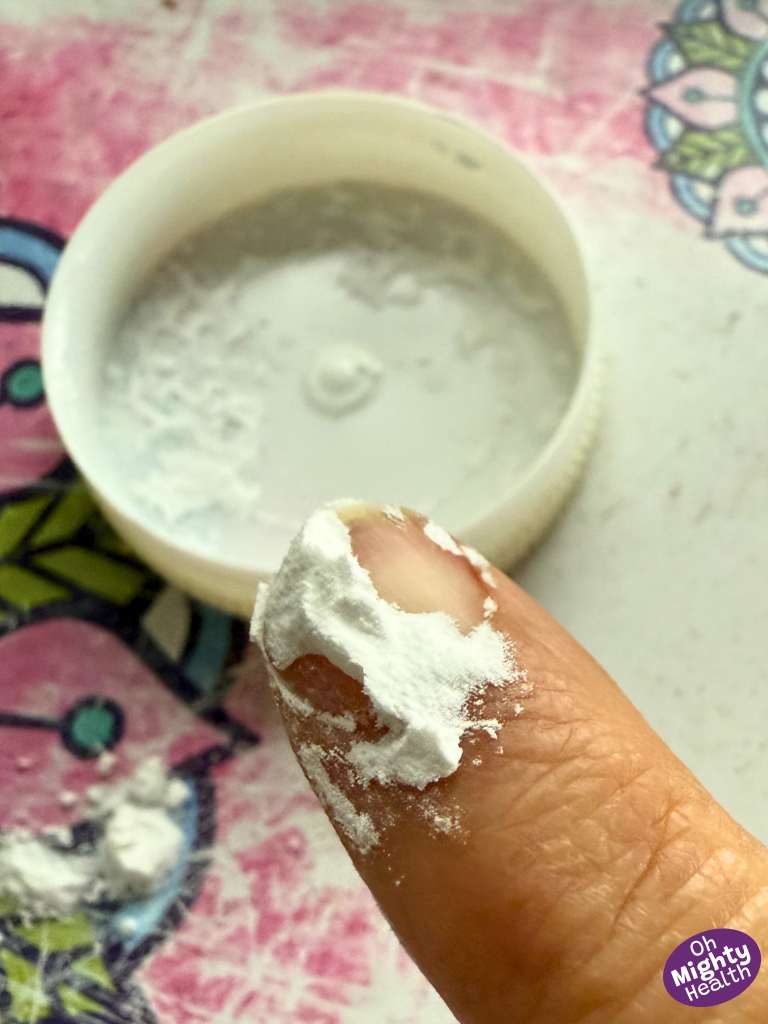
If you’re looking for a simple, non-toxic way to keep skin dry and comfortable, this is it.
Arrowroot powder has a very fine, soft texture that feels silky on the skin. It’s lightweight, breathable, and absorbs moisture without blocking your pores like some commercial powders do. This makes it a great alternative to talc, which many people now avoid due to concerns over contamination and long-term use.
It works by absorbing sweat and helping reduce that sticky feeling on hot days or in areas where skin rubs together. Think underarms, inner thighs, or anywhere prone to friction. What’s especially nice is that arrowroot doesn’t feel heavy or chalky—it just disappears into the skin and leaves it feeling soft.
You can use it on its own or blend it with other plant powders like kaolin clay or cornstarch (though arrowroot is usually better tolerated). It also works beautifully with a few drops of essential oil, if you’re after a light scent—but always patch test first.
It’s worth mentioning that arrowroot is not an antiperspirant. It won’t block sweating like aluminium-based products. But it manages moisture naturally, making you feel drier and fresher without disrupting your skin’s own process.
💡 HOW TO USE IT:
Sprinkle a little arrowroot powder onto clean, dry skin—just enough to take down any stickiness or shine. You can use a soft puff, a clean makeup brush, or simply your hands. It works beautifully on areas like the underarms, inner thighs, or anywhere that gets a bit too warm or prone to rubbing. You can use it just as it is, or blend it with a pinch of kaolin clay for extra absorbency. And if you enjoy a hint of scent, try mixing in a drop or two of your favourite essential oil, but go gently, and always patch test first. It’s light, breathable, and makes the skin feel soft without ever feeling coated.
>> Get my recommended arrowroot powder HERE.
2. Deodorant base
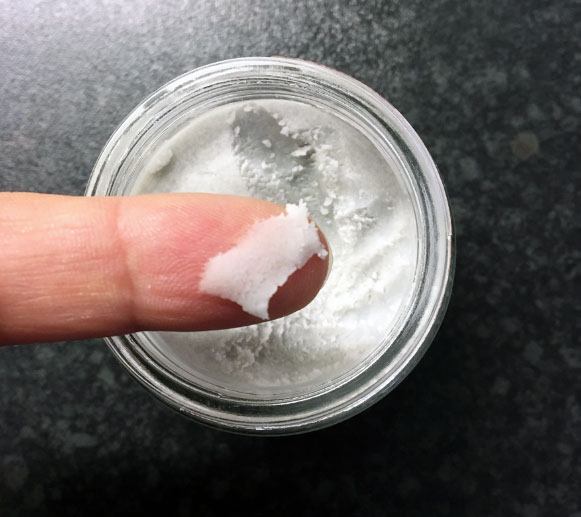
If you’re making your own or just want to understand the ingredient list a bit better, this is one of those underrated additions that quietly does a lot.
You might want to read my articles on DIY deodorant recipes with arrowroot and arrowroot powder vs baking soda for diy deodorant.
Arrowroot powder is excellent at absorbing excess moisture, which is key when you’re trying to stay dry without blocking your sweat glands. Unlike aluminium salts used in antiperspirants—which do block sweat—arrowroot lets your body sweat naturally while helping to manage the wetness that comes with it. That makes it ideal for people looking for a more natural, skin-friendly approach.
But there’s more. It also helps to create a smooth, non-greasy texture in oil-based deodorant balms. If you’ve ever tried a DIY deodorant that felt too oily or took ages to sink in, chances are it could’ve used a bit of arrowroot. It helps to bind the mix, reduce the greasy feel, and gives that soft-finish texture people love.
It’s often paired with other ingredients like shea butter, coconut oil, magnesium hydroxide, and essential oils (check my recipes here). Baking soda is a common one too, but as you know, it can be too harsh for some (I get a rash after 3 weeks or so of using it). Arrowroot is a much gentler option and doesn’t throw the skin’s pH off balance.
And if you’re formulating for sensitive skin, it’s a go-to. It’s non-irritating, sits well on the skin, and won’t interfere with active ingredients like antibacterial essential oils.
💡 HOW TO USE IT:
Start with about 15–20% arrowroot in your deodorant formula if you’re making your own. Blend it into your melted oils and butters before pouring the mixture into a jar or stick mould. If you’re applying a ready-made deodorant balm and want a drier finish, you can also dust a tiny bit of arrowroot over your underarms afterwards using a soft brush—it helps with any leftover tackiness and gives a lovely soft feel.
>> Get my recommended arrowroot powder HERE.
3. Thickener in skincare products
If you’ve ever made a rich balm or a whipped butter that ended up a little too oily or runny, arrowroot can be your fix. Just a small amount gives your product a smoother, more balanced texture—it cuts through the greasiness without making the formula feel dry or powdery.
What’s happening here is simple: arrowroot absorbs excess oil, giving your skincare creations a soft, velvety finish. It also helps them feel more elegant on the skin—especially useful if you’re working with heavier oils like shea, cocoa butter, or castor oil.
It’s a common trick in natural skincare when you want that ‘melt into the skin’ feel without leaving a greasy layer behind. You’ll find it used in body balms, foot creams, natural deodorants, and even creamy masks.
Another bonus? It’s non-comedogenic, meaning it won’t clog pores—ideal if you’re making products for the face or for people with sensitive skin.
4. Dry shampoo for oily hair
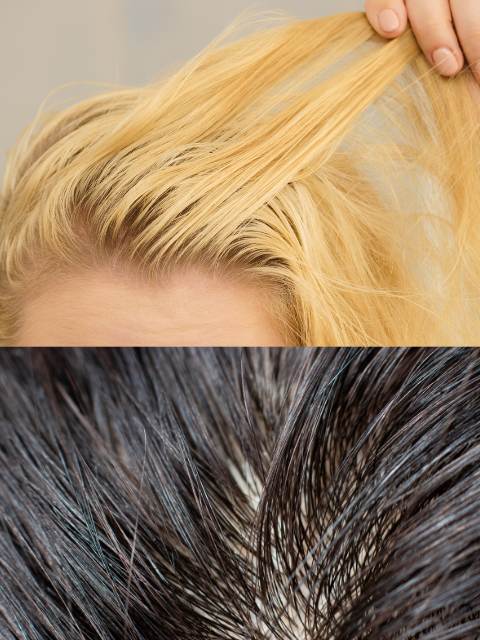
Arrowroot works by absorbing excess oil at the roots, giving your hair a fresher, cleaner look without the need for water.
It’s especially handy on those in-between days when your scalp feels greasy but you don’t want to go through the whole wash-dry-style routine.
What sets arrowroot apart is its fine, soft texture. It blends well into the scalp and doesn’t leave a heavy or gritty residue like some starches can. For lighter hair colours, it usually disappears completely. For darker hair, it helps to mix it with a bit of cocoa powder or activated charcoal so it blends in better.
Application’s simple: just sprinkle a small amount onto your roots (or use a clean makeup brush), let it sit for a minute, then massage it in and brush out. It soaks up the oil while adding a bit of volume too.
No synthetic fragrance, no aerosol, no irritation—just a light, breathable powder that leaves your scalp feeling refreshed.
And because it’s so gentle, it won’t throw off your scalp’s natural balance or lead to that itchy, build-up feeling some commercial dry shampoos cause.
💡 HOW TO USE IT:
Dip a clean makeup brush or fingers into a small bowl of arrowroot powder and gently tap it onto your roots, focusing on oily areas like the crown, parting, or hairline. Let it sit for a minute or two to absorb the oil, then massage it in with your fingertips and brush out any excess. If your hair is darker, mix the arrowroot with a bit of cocoa powder or activated charcoal first so it blends in better. You can do this in the morning or anytime your hair needs a refresh. No water, no fuss.
>> Get my recommended arrowroot powder HERE.
5. Face powder ingredient
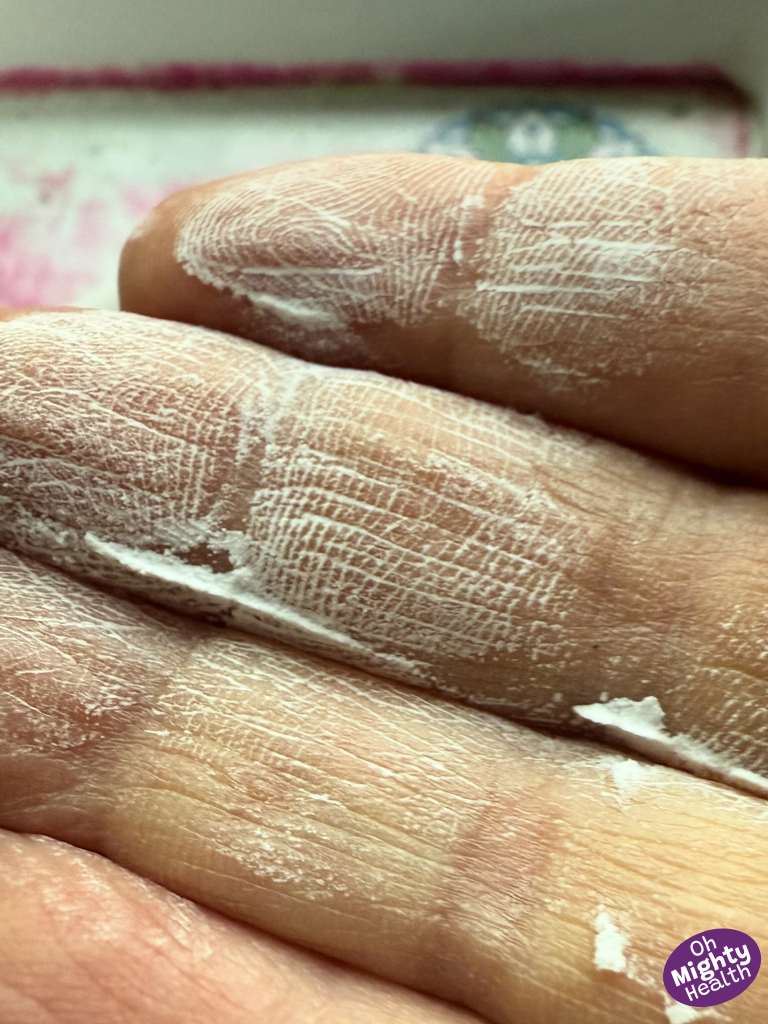
If you’re after a natural way to set your makeup, reduce shine, or just give your skin a soft matte finish, arrowroot is a lovely base to work with.
It has a light, silky feel that makes it ideal for finishing powders. On the skin, it helps blur shine without being cakey or drying, which is often the downside of conventional mattifying powders.
What it actually does is absorb a bit of surface oil while still letting your skin breathe. So if you’re someone who gets a little shiny in the T-zone or wants to tone down that overly dewy look, it can help balance things out—gently.
Arrowroot also acts as a binder for powdered mineral pigments and clays, so if you’re making tinted face powders or blushes, it helps everything blend evenly and sit well on the skin. You can mix it with natural colourants like cacao powder, pink clay, or iron oxides to create your own shades.
And because it’s so gentle, it’s often tolerated better than cornstarch, especially for sensitive or acne-prone skin types. It won’t clog pores, it doesn’t sit heavily on the face, and it feels more like a skincare ingredient than a makeup one.
💡 HOW TO USE IT:
Using a soft brush, lightly dust a small amount of arrowroot powder over your face—either on its own or after applying makeup. Focus on areas that tend to get shiny, like the T-zone. It sets makeup with a natural, matte finish and helps reduce oil without drying the skin. You can also blend it with a bit of cacao powder or clay to match your skin tone, or mix it with a touch of mica if you like a soft glow.
>> Get my recommended arrowroot powder HERE.
6. Anti-chafing powder
If you deal with skin rubbing (inner thighs, underarms, beneath the bust) arrowroot powder can help reduce that uncomfortable friction and keep the area dry.
It’s particularly useful in hot weather or during physical activity when sweat and movement make things worse.
Arrowroot works by creating a soft, dry barrier on the skin. It absorbs moisture, which is key in stopping that sticky, irritated feeling that leads to redness and soreness.
Unlike synthetic powders, it’s free from talc, aluminium, and synthetic fragrance. So it’s far gentler on sensitive areas.
You can dust it on as-is, or mix it with a little kaolin clay for added slip. If you want to take it up a notch, you can add a pinch of zinc oxide for extra soothing power, especially useful if you’re dealing with already irritated skin.
It’s also safe to reapply throughout the day. Just pat a small amount onto clean, dry skin and you’re good to go.
💡 HOW TO USE IT:
Lightly dust arrowroot powder onto clean, dry skin before heading out—especially on areas prone to rubbing, like inner thighs, underarms, or beneath the bust. You can use your hands, a puff, or a soft brush. Reapply during the day if needed, especially in hot weather or before exercise. If you want extra soothing, mix it with a little kaolin clay or a pinch of zinc oxide (as long as your skin tolerates it well). It helps reduce friction, keeps moisture in check, and leaves the skin feeling soft and comfortable.
>> Get my recommended arrowroot powder HERE.
7. Face masks
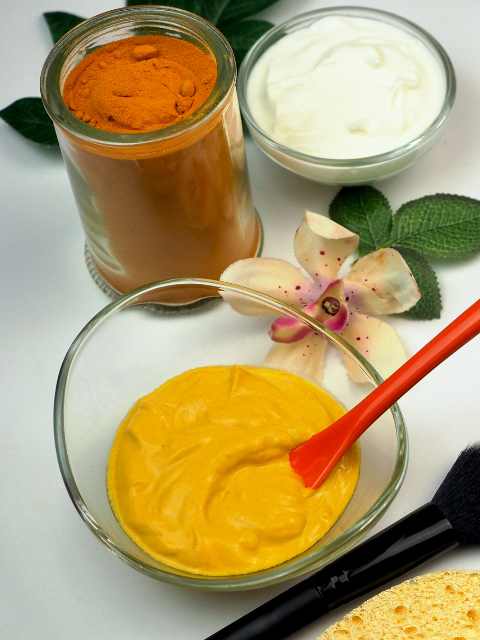
This one’s a bit of a secret weapon for anyone formulating with clays, botanical powders, or anything that needs a little softening and balance.
Arrowroot brings two main benefits to a mask: it soothes the skin and it improves texture. If you’re using strong clays like bentonite or rhassoul, which can sometimes feel a bit too drying or tight, arrowroot helps mellow them out.
It gives the mix a softer, silkier feel and helps prevent that cracking sensation on the face as the mask dries.
It’s also calming in its own right. While arrowroot doesn’t have active antibacterial or antioxidant compounds like some herbs, it’s gentle, non-irritating, and sits lightly on the skin, making it ideal for sensitive or reactive types. If someone’s had issues with redness or dryness after using clays, arrowroot can be the buffer that makes the mask more skin-friendly.
You can add it to powdered masks or stir a little into your pre-mixed blends. It pairs well with aloe vera, chamomile, calendula, or oat powder if you’re aiming for a soothing effect.
💡 HOW TO USE IT:
Add a teaspoon or so of arrowroot powder to your dry face mask blend to soften the texture and make it gentler on the skin. It works beautifully alongside clays, herbal powders, and soothing ingredients like oat or calendula. When you’re ready to use it, mix with water, aloe gel, or a hydrosol until it forms a smooth paste. Apply to clean skin, leave on for 5–10 minutes (don’t let it fully dry and crack), then rinse off gently. It helps calm the skin, reduce that tight feeling some masks can cause, and leaves your face feeling smooth and fresh.
>> Get my recommended arrowroot powder HERE.
8. Bath powders

If you like the idea of a soft, soothing soak without synthetic foaming agents or artificial fragrances, this is a beautiful ingredient to include.
Arrowroot adds a silky, cloud-like softness to bath blends. It doesn’t fizz or foam, it’s not that kind of ingredient, but what it does do is help disperse other ingredients more evenly in the water, especially powdered herbs, clays, or essential oils that have been mixed with a carrier like powdered oat or milk alternatives.
Because arrowroot is so fine and absorbent, it can help carry essential oils more safely in the bath (always in a blend—never add oils directly to the water on their own). It’s often used in bath milks and herbal soak blends for its texture and skin-soothing properties.
For dry or sensitive skin, it offers a gentle touch. It’s starch-based but doesn’t cause itchiness or irritation like cornstarch sometimes can. And when combined with things like colloidal oats, dried chamomile, or a little kaolin clay, it helps turn an ordinary soak into something much more nurturing.
It won’t leave a greasy film in the tub, and it rinses away easily (another reason it’s loved by those who make their own bath products).
💡 HOW TO USE IT:
Stir a few tablespoons of arrowroot powder into your bath along with other soothing ingredients like oat powder, dried herbs, or a splash of non-dairy milk. You can also pre-mix it into a jar with powdered calendula, chamomile, or clay and keep it on hand for easy use. If adding essential oils, blend them into the powder first, never drop them straight into the water. Soak for 15–20 minutes, then rinse as usual. Arrowroot gives the water a soft, silky feel and is especially lovely for dry or sensitive skin.
>> Get my recommended arrowroot powder HERE.
9. Soothing agent for rashes and irritation
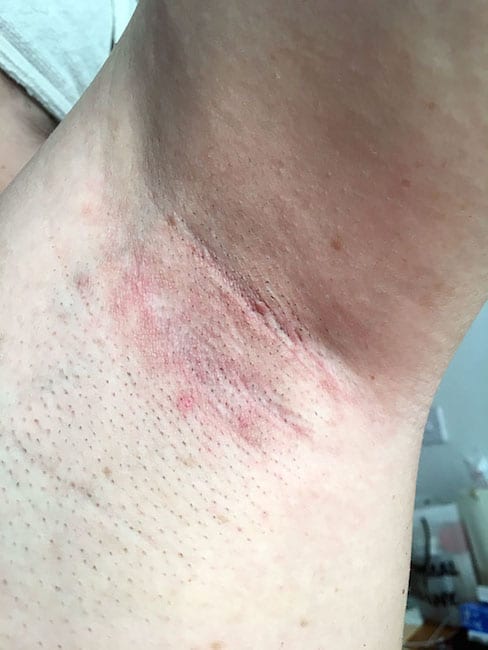
When the skin is red, itchy, or inflamed (whether from heat, friction, shaving, or sensitivity), arrowroot can help take the edge off.
It’s not a treatment in the medicinal sense, but it’s often used to calm and protect the skin while it heals.
Its ultra-fine texture creates a soft, breathable layer that helps keep the area dry without suffocating the skin.
This matters because moisture trapped against irritated skin tends to make things worse, whether you’re dealing with a heat rash or sensitivity from clothing or shaving.
You can dust it on lightly with a puff or clean brush, or even blend it with other skin-calming powders like calendula, oat, or chamomile. For extra soothing effect, a small amount of zinc oxide can be added. Just make sure it’s non-nano and safe for skin use.
Unlike some powders that can cause further irritation, arrowroot is neutral, non-comedogenic, and free from common allergens, making it ideal for reactive skin.
It’s not going to cure the underlying cause of the rash, but it’s a gentle way to keep the area more comfortable and allow your skin to do its thing.
💡 HOW TO USE IT:
Gently dust a small amount of arrowroot powder over clean, dry skin where there’s irritation, redness, or chafing. Use a soft puff, cotton pad, or clean fingertips—whatever feels most comfortable. It’s best applied after washing and patting the area dry. You can use it on its own or blend it with calming powders like chamomile, oat, or calendula. If the skin is raw or very sensitive, skip essential oils and just keep it simple. Reapply as needed to keep the area dry and reduce friction while the skin settles.
>> Get my recommended arrowroot powder HERE.
10. Foot powder
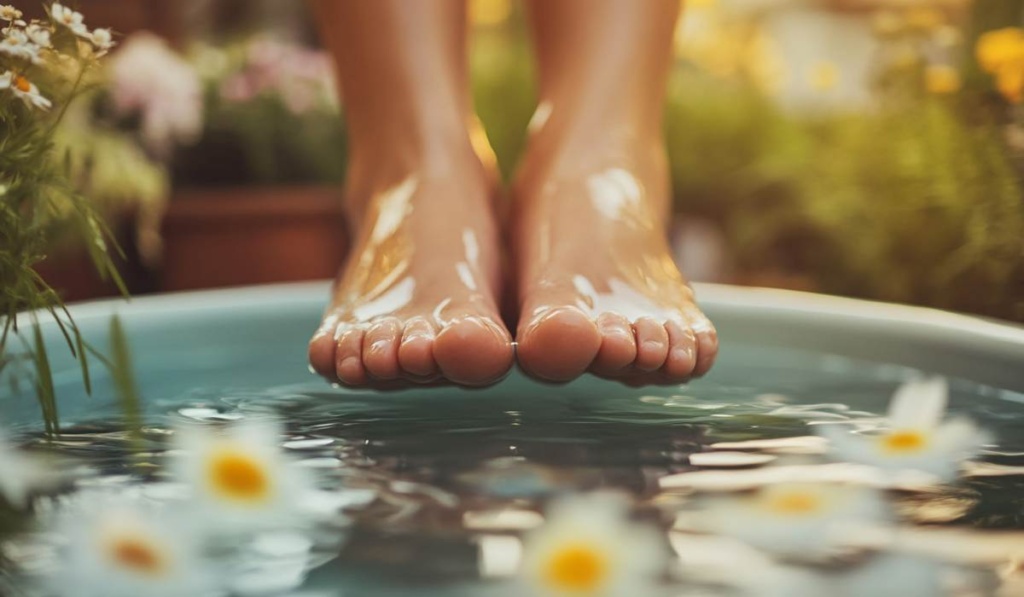
Feet take a lot of wear (and sweat!).
Arrowroot is brilliant here because of its ability to absorb moisture without clogging the skin. It helps keep feet dry, reduces the stickiness that leads to discomfort, and creates a softer feel inside socks or shoes.
Unlike commercial foot powders that are often packed with synthetic fragrance and talc, arrowroot is simple, gentle, and plant-based.
It won’t sting, irritate cracked heels, or leave that strong artificial scent behind. It just absorbs sweat and leaves your skin feeling smooth.
If odour is also an issue, arrowroot makes a perfect base to combine with natural antibacterial powders or oils. Think tea tree, sage, or lavender essential oil (pre-diluted and dried into the powder), or a pinch of baking soda if your skin tolerates it. You can also add kaolin clay or activated charcoal for extra deodorising effect.
Use it in the morning before putting on socks, or at night after a foot soak to keep things balanced.
You can also sprinkle a small amount inside shoes to help absorb lingering moisture and reduce odour over time.
💡 HOW TO USE IT:
Sprinkle a small amount of arrowroot powder onto clean, dry feet, focusing on the soles, between the toes, and anywhere that tends to get sweaty. You can use it on its own or mix it with a bit of baking soda (if your skin tolerates it), kaolin clay, or a few drops of essential oil blended in beforehand. It’s also great shaken directly into shoes or onto insoles to help keep things dry and fresh throughout the day. Reapply as needed, especially in warm weather or after long walks.
>> Get my recommended arrowroot powder HERE.
11. Natural makeup primer
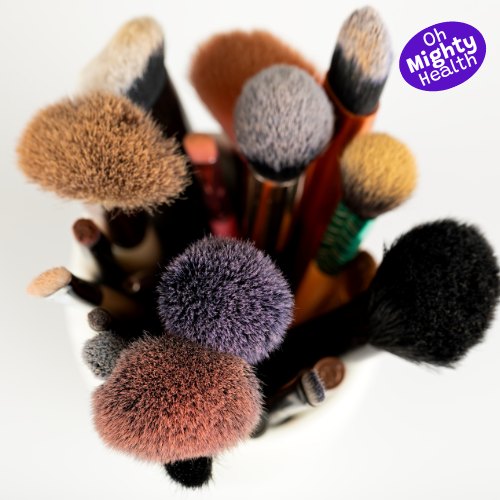
If your skin tends to get oily during the day or makeup just doesn’t sit well, a light dusting of arrowroot can act as a gentle, mattifying primer.
It helps absorb excess oil on the surface, smooths out the skin’s texture a bit, and gives your foundation something to hold onto without the silicones or synthetic fillers found in conventional primers.
It’s especially handy if you prefer a more minimal routine. Just apply a tiny amount to clean, moisturised skin using a soft brush or powder puff.
Focus on areas that tend to get shiny like the forehead, nose, and chin. It won’t block your pores or leave a thick layer behind; it’s just enough to take down surface shine and help makeup last longer.
If you’re making your own primer blend, arrowroot works well with kaolin clay or rice powder, and you can even add a touch of iron oxide if you want a little tint.
It’s not going to fill in lines or blur everything like silicone-based primers do, but for those who want a natural, light and breathable feel it’s a really clean and skin-friendly option.
💡 HOW TO USE IT:
After moisturising, dust a light layer of arrowroot powder over your face using a soft brush, focusing on areas that tend to get oily, like your forehead, nose, and chin. It helps take down shine and gives your skin a smoother feel before applying foundation or tinted moisturiser. You can use it on its own or blend it with a little kaolin clay or rice powder for extra oil control. It won’t blur like silicone primers, but it gives a lovely breathable base that helps makeup sit more comfortably and last a little longer.
>> Get my recommended arrowroot powder HERE.
12. Pressed eyeshadow and powder compacts
Whether you’re making your own eyeshadow, blush, or face powder compacts, arrowroot can help bind everything together and improve the finish.
Pressed powders need more than just colour. They need texture, slip, and something to hold them in place without crumbling. Arrowroot steps in to provide a soft, blendable base that makes powders easier to apply and more comfortable on the skin.
It helps distribute pigments evenly so you don’t end up with blotchy patches or clumps of colour. It also adds a smooth glide, which is especially helpful when working with mineral ingredients that can sometimes feel gritty or chalky.
When used in small amounts, arrowroot acts as a gentle filler, bulking out formulas without overpowering the active ingredients.
If you’re adding zinc oxide, iron oxides, or natural micas for colour and coverage, arrowroot helps balance the blend and gives it that soft focus effect.
To press your powder, it combines beautifully with a binding agent like jojoba oil or fractionated coconut oil, just enough to hold it all together in the pan. You get a smoother finish, better payoff, and less dust when you dip your brush in.
It’s also kind to the skin: no clogging, no irritation, just a natural base that lets the other ingredients shine.
💡 HOW TO USE IT:
Use arrowroot as part of your base when blending powdered pigments for eyeshadows, blushes, or face powders. It helps soften strong colours, adds smoothness, and makes the product easier to apply. Start by mixing your colourants (like mica, iron oxides, or clay) with a small amount of arrowroot until the texture feels fine and silky. To press the powder, add a few drops of a lightweight oil—like jojoba or fractionated coconut—just enough to hold everything together. Press firmly into a pan using a spoon or coin wrapped in fabric. Leave to set for a day or two, and your powder’s ready to use. Arrowroot helps give a soft, blendable finish that feels comfortable on the skin.
>> Get my recommended arrowroot powder HERE.
13. After-sun care
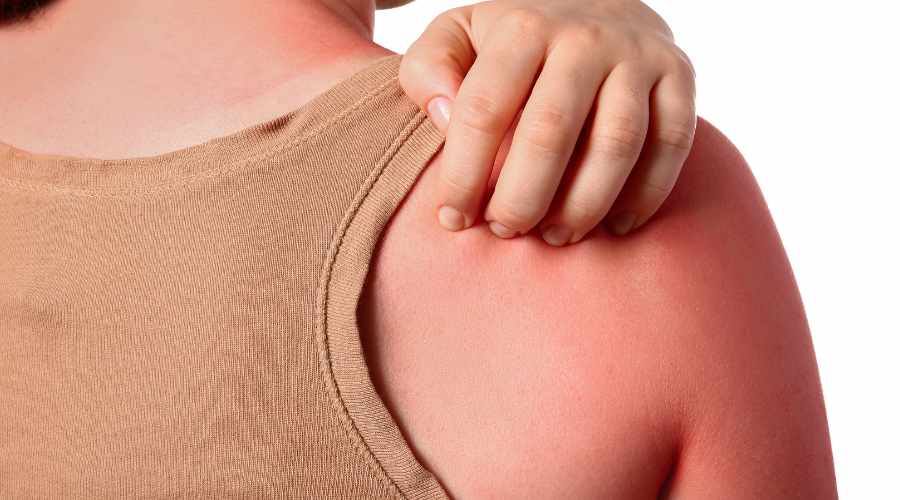
If your skin feels hot, tight, or a bit irritated after sun exposure, arrowroot can offer a light, soothing touch that doesn’t overwhelm the skin.
What makes it so helpful is its ability to absorb that slight surface moisture from sweat or sun oils, while still feeling cooling and breathable on the skin.
It doesn’t add heaviness, and unlike creams, it won’t trap heat—something your skin definitely doesn’t need after sun.
It’s often used in after-sun body powders or sprays, usually paired with calming ingredients like aloe vera powder, calendula, chamomile, or lavender essential oil (always diluted properly!).
Arrowroot helps distribute these ingredients evenly and gives a soft, matte finish that feels comforting, especially if there’s any stickiness from sun lotions or sweat.
For anyone who reacts badly to commercial after-sun gels (which are often packed with alcohol or fragrance), this can be a gentle alternative. Dust it lightly over the skin or mix into a water-based mist or aloe blend for a cooling, non-greasy effect.
It won’t “treat” sunburn, but it does help support the skin by keeping it dry, calm, and free from further irritation.
💡 HOW TO USE IT:
After sun exposure, once your skin is clean and completely dry, lightly dust a small amount of arrowroot powder over any areas that feel hot, sticky, or a little irritated. It helps absorb surface moisture without trapping heat, leaving your skin feeling soft and calm. You can use it on its own or mix it with a little oat or calendula powder for extra soothing. If you’re adding essential oils, make sure they’re well-blended into the powder first, and go very gently: sun-exposed skin can be extra sensitive. This isn’t a treatment for sunburn, but it can help make your skin feel more comfortable while it recovers.
>> Get my recommended arrowroot powder HERE.
14. Natural carpet freshener
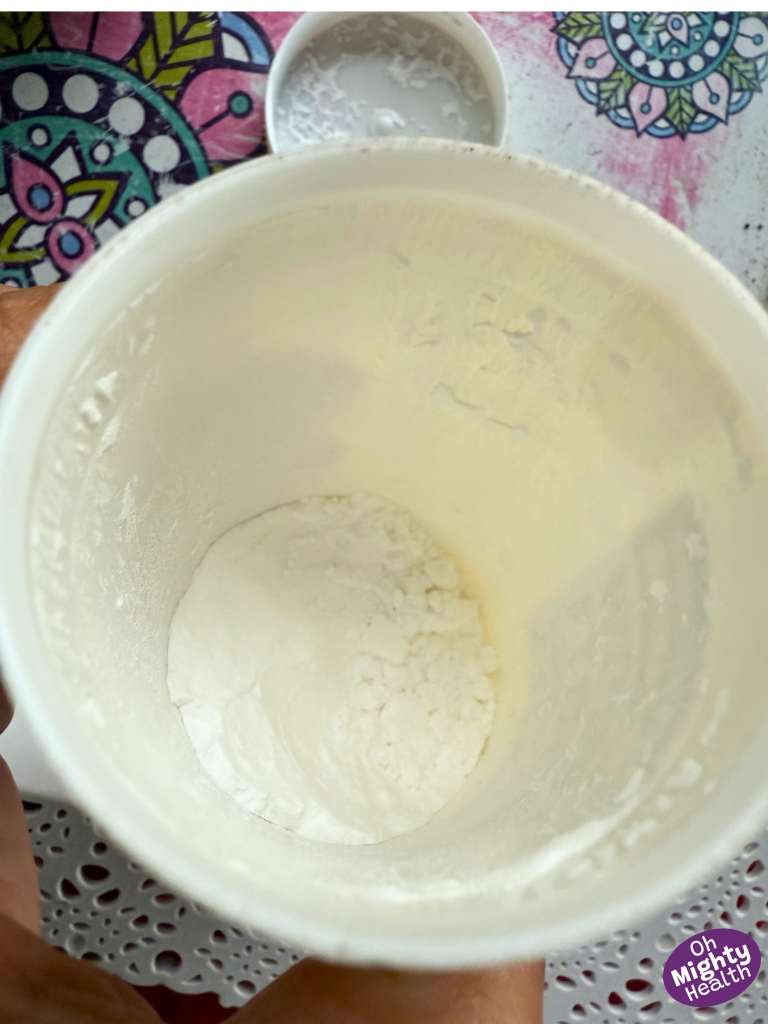
Did you know you can use arrowroot as a base for DIY carpet freshening powders?
If you want to skip the synthetic sprays and go for something natural, scentable, and safe, arrowroot works beautifully.
Because it’s so fine and absorbent, arrowroot acts as a carrier for essential oils. That means you can use it to evenly disperse scent through your carpet or rug fibres without the risk of staining or leaving behind clumps.
It’s light, easy to vacuum out, and doesn’t leave a residue.
You simply mix it with a few drops of essential oil (lavender, lemon, eucalyptus, or rosemary are popular choices – DO NOT USE ESSENTIAL OILS IF YOU HAVE PETS!), let it sit for a few hours to bind properly, and then sprinkle it over the carpet. Leave it for 10–30 minutes, then vacuum as usual.
It absorbs odours while leaving a subtle clean scent behind. Again, if you have pets, please skip the essential oils altogether and JUST use arrowroot on its own as a neutral odour absorber.
💡 HOW TO USE IT:
Sprinkle arrowroot powder lightly over your carpet or rug, leave it for 15–30 minutes, and vacuum as usual. It helps absorb odours without leaving behind any residue. You can also use it inside fabric sachets to freshen drawers, wardrobes, or even shoes.
🐾 Note if you have pets: Stick to unscented arrowroot powder when using it as a carpet freshener or room powder. Also, many essential oils—especially tea tree, eucalyptus, citrus, and peppermint—can be irritating or even toxic to animals, even when used in small amounts so I would not use them to be on the safe side. More information here.
15. Drawer and shoe freshener

Arrowroot can be used for keeping musty drawers and shoes smelling clean without using synthetic fragrances or chemical sprays.
It works as a gentle moisture absorber and scent carrier, which makes it ideal for small enclosed spaces like drawers, wardrobes, and inside shoes.
You can think of it as a soft, scentable powder base that helps keep things dry and lightly fragrant over time.
To use it, simply mix arrowroot with a few drops of essential oil (lavender, cedarwood, lemon, clove—whatever you like), and spoon it into small fabric sachets, muslin bags, or even clean socks tied with a string.
These can then be tucked into shoes, drawers, storage boxes, or anywhere that tends to hold on to damp or stale smells.
It quietly absorbs both moisture and odour, and it’s safe to use around clothes, as long as you keep it contained in a breathable bag. And unlike baking soda, which can feel gritty or spill easily, arrowroot is finer and softer, so it’s less messy to work with.
You can refresh the scent every few weeks by adding a couple more drops of oil directly to the sachet. Simple, clean, and it works.
💡 HOW TO USE IT:
Spoon a few tablespoons of arrowroot powder into a small fabric sachet, muslin bag, or even a clean sock tied at the top. Add a couple of drops of essential oil if you like (lavender always work so well) but make sure to mix the oil into the powder first before sealing the bag. Tuck it into drawers, wardrobes, storage boxes, or inside shoes to help absorb moisture and neutralise musty smells. Refresh the scent every few weeks with another drop or two of oil, or replace the powder when it feels damp or loses its scent. For shoes, unscented is SAFEST if pets are around.
>> Get my recommended arrowroot powder HERE.
16. Face blotting powder
If your skin gets oily throughout the day (especially across the forehead, nose, or chin) this is a simple, no-fuss way to manage shine without piling on more product.
Arrowroot works by absorbing excess surface oil, leaving your skin with a soft, matte finish.
It doesn’t clog pores, doesn’t dry out your skin, and doesn’t add texture—it just gently takes down the shine. Perfect if you want to refresh your look without disrupting your makeup or making things cakey.
You can dust it on with a clean brush, use a puff, or even carry a small pot of it in your bag with a reusable cloth or cotton round. It’s incredibly lightweight, so it won’t build up or look chalky, even on bare skin.
It’s especially good for people with sensitive or acne-prone skin who want to avoid the silicones, mineral oils, or synthetic fillers often found in commercial blotting powders.
You can use it on its own or mix in a pinch of mica or tinted clay if you want a hint of colour.
But even plain arrowroot does the job beautifully: no scent, no residue, just clean matte skin whenever you need it!
💡 HOW TO USE IT:
Tap a small amount of arrowroot powder into your palm or a clean lid, then use a soft brush or blotting pad to gently dab it onto oily areas, usually the forehead, nose, and chin. It works best on clean skin or over makeup to take down shine without adding heaviness. You can use it on its own or mix in a little tinted clay or cacao powder if you want it to match your skin tone. It’s easy to keep a small container in your bag for touch-ups during the day, just enough to freshen up without caking or clogging pores.
>> Get my recommended arrowroot powder HERE.
17. Carrier for essential oils in powder blends
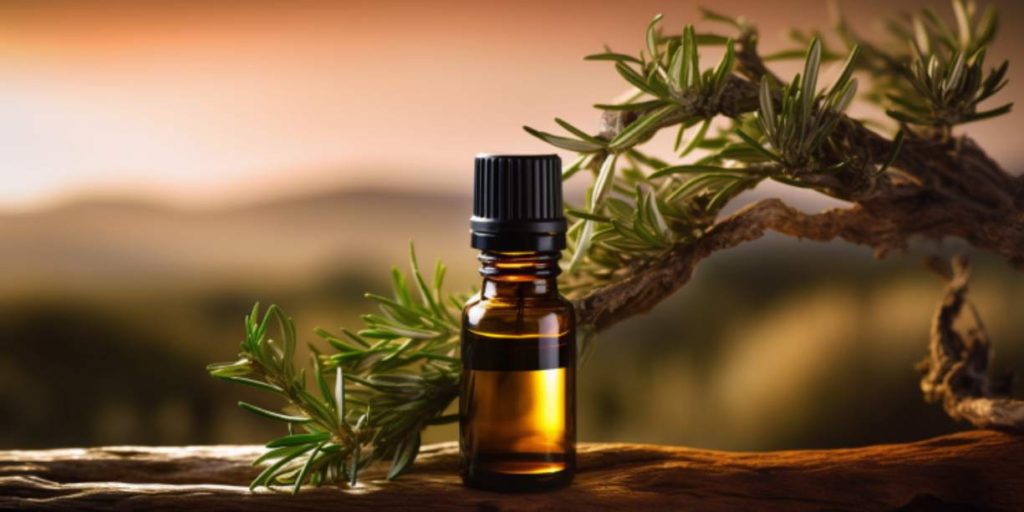
Now about arrowroot as a natural carrier for essential oils, especially in powder-based products like deodorants, foot powders, body dusting powders, and dry shampoo.
Essential oils need to be diluted, always. And when you’re working with dry formulations, arrowroot does a fantastic job of dispersing those oils evenly without causing clumping or making the powder too wet.
What you do is add your essential oils drop by drop into the arrowroot, mixing thoroughly between each drop. The powder absorbs the oils gently and helps distribute their scent and properties throughout the blend, whether you’re making something calming, cleansing, or deodorising.
It’s especially useful when formulating with oils that have antibacterial, antifungal, or cooling properties, like tea tree, lavender, eucalyptus, peppermint, or rose geranium.
Rather than having concentrated patches of scent or potential skin irritation, the arrowroot helps deliver the oils evenly and safely across the skin.
It also holds the scent beautifully for a longer period—so you don’t end up with that “gone in five minutes” effect you sometimes get with quick-drying mists or sprays.
Just be mindful of quantity—1 to 2% essential oil is usually plenty for body powders. Always patch test if you’re working with sensitive skin.
💡 HOW TO USE IT:
Place the amount of arrowroot powder you need in a small bowl, then add essential oils one drop at a time, mixing thoroughly between each drop to help the powder absorb evenly. This prevents clumping and avoids concentrated spots that could irritate the skin. Use around 1–2% essential oil in total (that’s roughly 6–12 drops per 10g of powder, depending on the oil and what you’re using it for). Once blended, you can add it to body powders, foot powders, deodorant blends, or sachets. Always patch test if it’ll be going directly on the skin, and store the mix in a sealed jar away from light and heat.
>> Get my recommended arrowroot powder HERE.
Comparing Arrowroot with Other Natural Powders
Hopefully the below is a helpful table of comparison between powders:
| Powder | Texture | Absorbency | Skin Sensitivity | Comedogenic Rating | Soothing Properties | Oil Compatibility | Colour/Tint | Residue | Pet-Safe | Common Uses |
|---|---|---|---|---|---|---|---|---|---|---|
| Arrowroot | Very fine, silky | High | Very gentle | 0 (non-comedogenic) | Mildly soothing | Excellent | White, easy to tint | Minimal | Yes (unscented) | Body powder, dry shampoo, deodorant |
| Cornstarch | Soft but heavier | High | May cause irritation for some | 1–2 | None | Moderate | White, easy to tint | Can feel sticky | Yes (unscented) | Deodorant, body powder |
| Kaolin clay | Soft, smooth | Moderate | Gentle | 0 | Yes | Good | Pale pink or white | Low | Yes | Face masks, finishing powder |
| Baking soda | Grainy, slightly gritty | Very high | Can be irritating | 2–3 | No | Poor | White | Can feel gritty or leave residue | Use with caution | Deodorant, foot powder, odour control |
| Oat flour | Soft, slightly coarse | Low to moderate | Very gentle | 0 | Yes (anti-inflammatory) | Excellent | Cream to beige | Soft residue | Yes | Face masks, soothing baths |
| Bentonite | Very fine, dense | Very high | Can be drying | 0 | Mild | Moderate | Greyish/green | Can cling to skin | Yes | Face masks, detox baths |
| Talc | Very fine, slippery | High | Linked to respiratory concerns | 1 | No | Poor | Bright white | Can cling and feel heavy | No – not recommended | Old-fashioned body powders, industrial use |
My Final thoughts
Arrowroot is the kind of ingredient that truly earns its place in your routine.
No hype, no drama—just clean, effective, plant-based support for your skin, your hair, and even your home. What I love most is how adaptable it is. You can use it on its own or as part of something more elaborate, but it always brings that same softness and ease.
Whether you’re formulating skincare, making everyday body powders, or freshening up your space naturally, arrowroot lets you do it without compromise. It doesn’t overpower anything—it simply enhances what’s already good.
I hope these ideas have sparked something useful for you. Maybe even a bit of inspiration to look at the ingredients you already have in a new way.
As always, go gently, patch test when needed, and enjoy the process. Simplicity often has the most to offer.
Patri xx
Resources
1. Mandriota SJ, Sappino A-P. The postulated innocuity of lifetime exposure to aluminium should be reappraised. Front Oncol [Internet]. 2023 [cited 2025 Mar 27]; 13:1159899. Available from: https://www.ncbi.nlm.nih.gov/pmc/articles/PMC10406518/.
2. Johnson NF. Inhalation Toxicity of Talc. J Aerosol Med Pulm Drug Deliv. 2021; 34(2):79–107.

